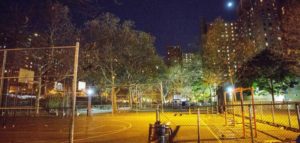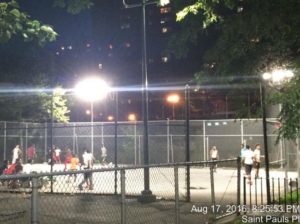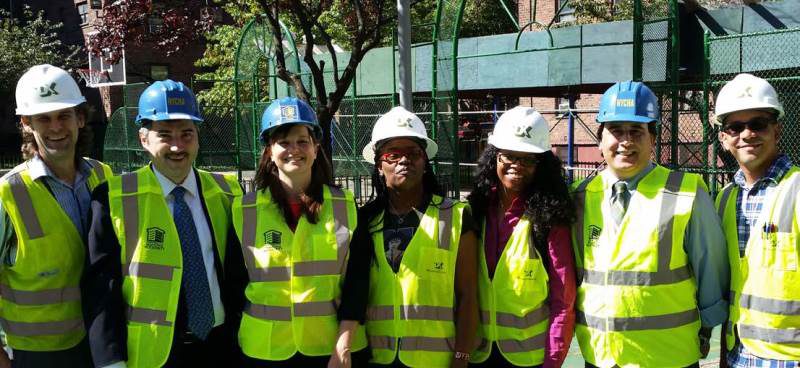NYCHA’s Capital Team Lights the Way to Safety

It’s been a busy year for Capital Projects’ City Capital group, which oversees projects funded by the City Council, the Mayor’s Office and the Manhattan District Attorney. As part of the Mayor’s Action Plan for Neighborhood Safety (MAP), state-of-the-art, energy- efficient LED lighting is being installed at 15 developments, replacing and augmenting outdated lighting, some more than 50 years old.
“The state-of-the-art lighting changes the dynamics of the neighborhoods dramatically,” said Vice President for Public Safety (“Chief”) Gerald Nelson. “The LED light bulbs are as bright as daylight. It makes a big difference and people really do feel safer.”
A lot is riding on NYCHA’s timely completion of the installations. “This complex portfolio is high priority and high visibility work, with the Mayor and Chair Olatoye closely involved,” said recently appointed Executive Vice President for Capital Projects Deborah Goddard. “With special funding provided by the Mayor’s Office and other sources, we want to prove the value of the investment and show that the Capital Projects Division can complete its work expeditiously and efficiently.”
Vice President for Construction Programs Farhan Syed confirmed that work is proceeding at a rapid pace. “Our City Capital group is concurrently managing the entire MAP lighting portfolio. Ten of these sites will be completed by the end of the year,” he said. “The City Capital group has already completed installations at four developments and they expect to complete installations at six additional sites this year.”
Completed developments include Polo Grounds Towers in Harlem, Bushwick Houses in Brooklyn, Boulevard Houses in Brooklyn, and Stapleton Houses in Staten Island. Upcoming work will be completed at Butler Houses in the Bronx, Saint Nicholas Houses in Manhattan, Castle Hill Houses in the Bronx, Ingersoll Houses in Brooklyn, and two sites at Van Dyke Houses in Brooklyn.
“Our team listens carefully to the property manager and residents at each development, whose input is critical for our lighting improvements,” Mr. Syed said.
Help Communities Thrive
MAP is a comprehensive strategy to reduce violence and increase neighborhood safety at developments that accounted for 20 percent of violent crime in public housing in 2014.
The exterior lighting is part of the initial phase of MAP, which includes enhanced coordination between the NYPD, NYCHA, City service agencies and residents to address physical, economic, and social conditions to create safe and strong neighborhoods.
In addition to LED lighting, other security enhancements that the City Capital group will complete include layered access control doors and CCTV safety cameras.
“If you have darks spots in development grounds, the safety cameras won’t do much good,” said Ms. Goddard, noting the sequential nature of the work.
Other aspects of MAP help the community thrive by focusing on employment opportunities and bringing a cadre of City resources provided by different units from the Mayor’s Office of Domestic Violence.
“Our construction management firms have employed residents through Section 3 and our resident employment program, and we’ve had very positive experiences,” said Administrative Project Manager Paul Lombardi, who directly oversees the construction management firms completing the work. Residents have also been employed by contractors that NYCHA hires for construction work. “The firms put a lot of time and effort into training the residents with the goal of keeping them employed, and some have been hired as permanent members,” said Mr. Lombardi.
“Paul gets most of the credit for keeping these projects running smoothly, on time and on budget,” Mr. Syed noted.
For the second year in a row, crime is down at NYCHA’s MAP developments in Fiscal Year 2016 compared to Fiscal Year 2014, with violent crime down 2.24 percent and shootings down 14.7 percent.
“We’re having good results in overall reduction of crime at the MAP developments, so far,” said Chief Nelson.
In a partial return to a past practice, each MAP development now has police officers assigned solely to that location. “They are there to help solve problems and engage the community, not just to police them,” said Chief Nelson.









